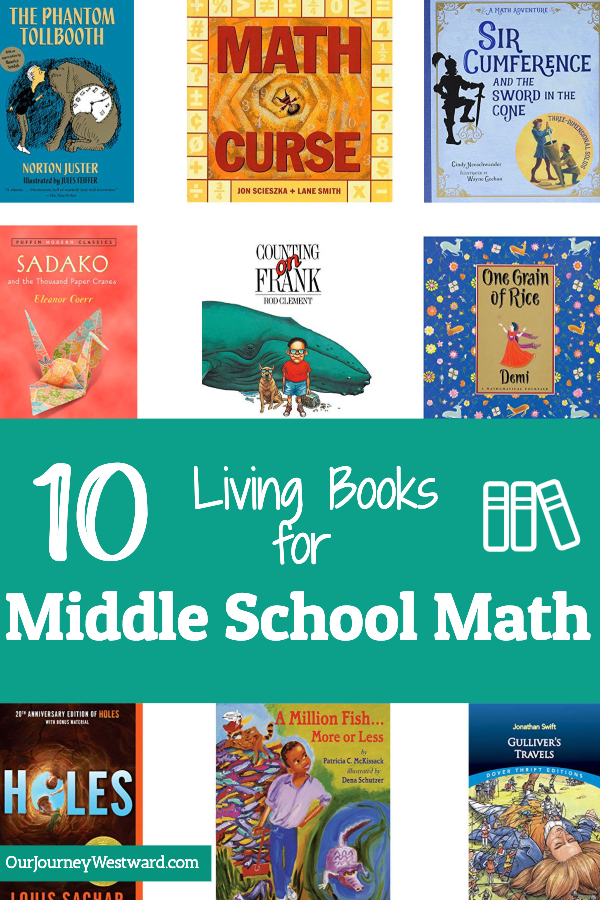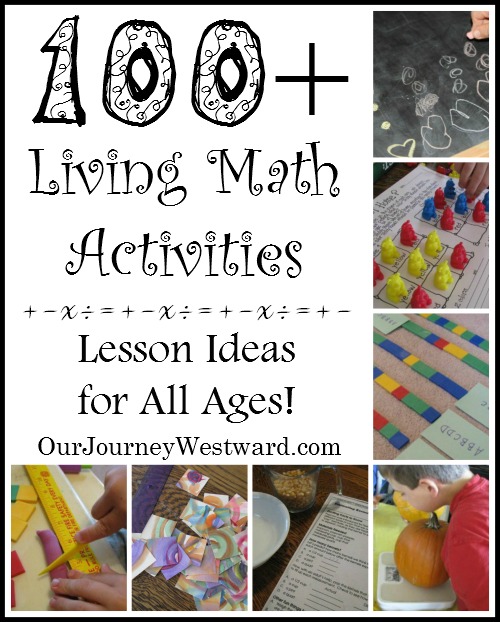10 Living Books for Middle School Math
Living math is wonderful, especially the kind that involves living literature. So many people think math and literature connections only make sense for the elementary years, but middle school students still benefit very much from the connection! This list of living books for middle school math is perfect for making those connections and bringing some excitement and pleasure to math time.

This post contains affiliate links.
Living Books for Middle School Math
The Phantom Tollbooth is rich in imagination and character development, not to mention math concepts. Ratio, proportion, averages, measurement, estimation, geometry, and more are seamlessly woven throughout the storyline.
Math Curse is a goofy picture book that can be read in one sitting. Each page offers great opportunities for various math explorations like problem-solving, averages, percent, volume, sequencing, permutations, and more. Children who are less than enthusiastic about math might find the book somewhat painless.
Sir Cumference and the Sword in the Cone is just one of an entire series of Sir Cumference math stories. While some of the books are appropriate for older elementary, many of them cover more in-depth middle school topics – like finding the volume of cones or the area of circles. This series is a top favorite!
Sadako and the Thousand Paper Cranes is mostly historical fiction with a geometry twist. It takes place in Japan after the bombing of Hiroshima. After wiping the tears away, have some fun with this origami lesson.
Counting On Frank is somewhat similar to Math Curse (above), with a character who is a little more thoughtful about math. Everything he thinks about seems to go through a math funnel. It’s especially good for showing the real-life side of math. Find several activity suggestions to go along with the book here.
One Grain Of Rice is a favorite multicultural tale with a wonderful moral at the end. The book teaches the power of doubling painlessly, as well as covering large place values. Enjoy this lesson after reading the book.
Holes was a book I was skeptical about allowing my children to read at first. I had the impression it handled issues that were too big, but I felt more comfortable after previewing it. It has since become one of Caleb’s very favorite books ever (and that’s saying a lot since very few books even make the “it was okay” list.) Many math lessons can be drawn from this book including percentages, ratios, proportions, and more.
A Million Fish…More or Less is a book that I disliked the first time I read it. The tall tales seemed silly and hard for children to grasp. However, looking at the book from the perspective of math potential for older children, it earned a spot in my top 10! Set in Louisiana and using the traditional Bayou language, the characters’ tales about events tend to grow. Here is an article that talks about using estimation with kids.
Gulliver’s Travels is a classic tale about a shipwrecked English surgeon who finds himself held captive by a group of little people, among other sea adventures. Lessons on ratio, proportion, and measurement can be easily tied into the book. Here are a few math activity ideas that go along with the book.
Chasing Vermeer is an art mystery that covers all sorts of mathematical concepts like patterns, symmetry, shapes, Roman numerals, and more. There’s even a bit of math history thrown in! Please be aware that the Lord’s name is taken in vain in this book.
Living Math Book and Activity Ideas for You
You’ll love the other posts in this Living Literature Top 10 Series. Be sure to check out the Living Math Matters Series full of practical living math lessons!
Learn More About Living Math
The possibilities of living math in homeschooling are endless. Loving Living Math (a how-to guide) and Living Math (a video training) share encouraging ideas to practically incorporate powerful activities. There are so many benefits to living math and these must-have resources help you get started!
-

-
 Loving Living Math$20.00
Loving Living Math$20.00














Thank you! I love this. I am personally not a fan of math and unfortunately I am afraid I share that message with my children. We have tried a different approach to math this year (and it seems to be a positive step) and I believe adding in some of these books would be a big plus as well. I shared this on our FB page!
Thanks, Susan! These books really are great – I hope they spice up your math time. 🙂
A Million Fish… More or Less- lesson activities site is an error…?
Yes, Heather. Unfortunately, that link is not working right now. I’m leaving it in hopes that the page magically comes alive again because it has such great ideas. Thanks for the comment to let me know!
Thank you Cindy so much for sharing favorites! We love books! And especially living books!
I did want to share though on the book Chasing Vermeer: my daughter informed me that they use God’s name in vain.
Thank you, Dawn! You’re right. Will add that to my post.
Lawn Boy and Lawn Boy Returns….it is upper elementary. But Middle Schoolers will understand the investment and entrepreneurial ideas better.
I am so new to this concept. I have a son who just don’t get math. We’ve tried everything. Could someone please help me! Is this something you use in supplement to a curriculm could you do this as a stand alone math. How would I make sure my kids get everything they need if I did this? Any help is greatly appreciated.
Leann, do you mean should you use math literature as stand alone math? If so, the answer would be no. Math literature is meant to supplement math concepts a student is learning. If you would like some help with math for your son, I offer homeschool consultations. You can learn more about them at https://ourjourneywestward.com/homeschool-consulting/.
You can access the A Million Fish activities through the Wayback Archives – for example at this link: https://web.archive.org/web/20120126073106/https://sci.tamucc.edu/~eyoung/Literature%20webpages/Leonor/million_fish.html
Hope this helps someone! 🙂
Thanks, Sunshine! 🙂
Great list of living books for math! Can I add another suggestion? Math and Magic in Wonderland : https://www.amazon.com/Math-Magic-Wonderland-Lilac-Mohr/dp/1532894422 Here’s the description: Lulu and Elizabeth are two girls who love to play with numbers, words, and (on occasion) toy swords. Join them on a grand adventure, where classic math and logic riddles lead the way through a world inspired by Lewis Carroll’s poetry.
I thought this article was very helpful. I’m putting together a mathematics/literacy classroom library. The only issue is many of the links to the lesson ideas do not work anymore.
I’d like to add a book, Wrappers Wanted: A Mathematical Adventure in Surface Area. This book teaches students how to measure the surface area of a rectangular prism. This is often a difficult concept for middle school students to grasp. This unique tale takes the reader up to the North Pole and describes how Santa challenges his top elf, Snips Cleaver, to conserve paper because the North Pole is “going green.” The elves fill out an application, sing about the area of a triangle, and celebrate the accomplishments of their friends. Jump in and join the adventure with Snips, Hex, Jenn, Mikey, and a host of other elves as they discover that there is usually more than one way to solve a problem.
Regarding “Chasing Vermeer,” can you tell me if the bad language is frequent, or is it something that could be easily dealt with by using white-out?
Thank you very much,
Debbie
It’s been a little while since I’ve read it, but I don’t remember is being terrible. If I remember correctly, the Lord’s name is used in vain a couple of times and there were some mentions of “fart” and “darn”.